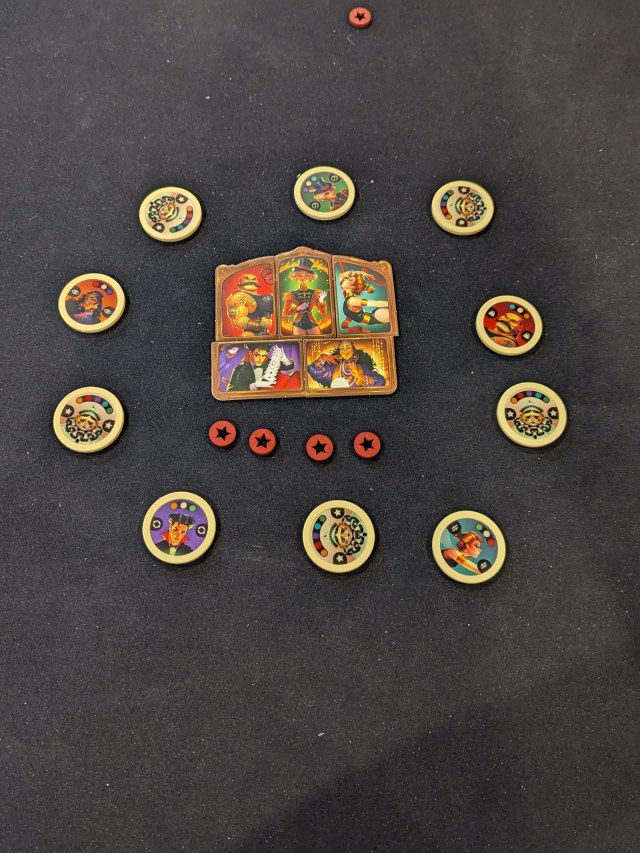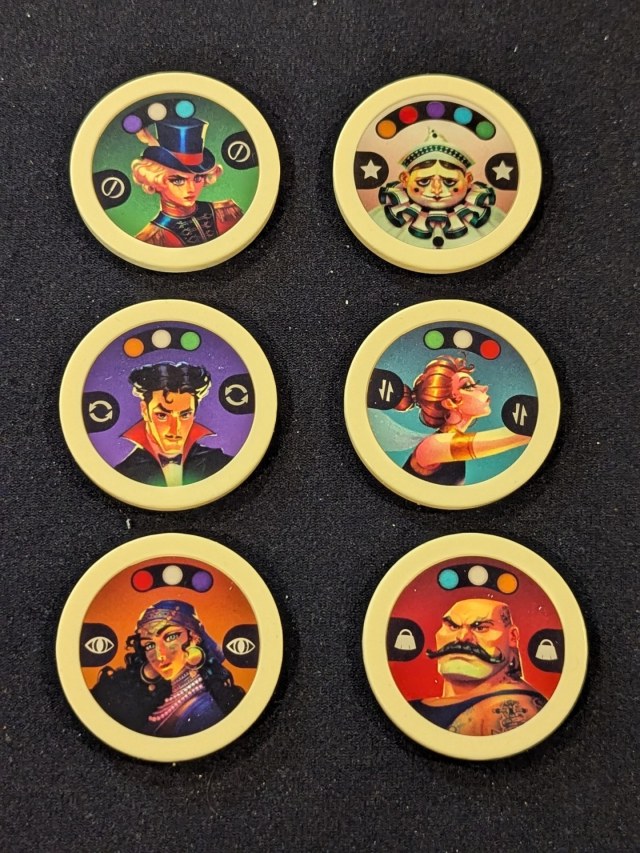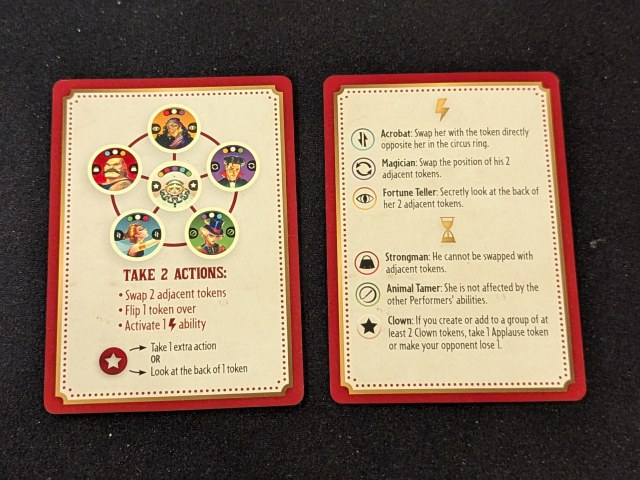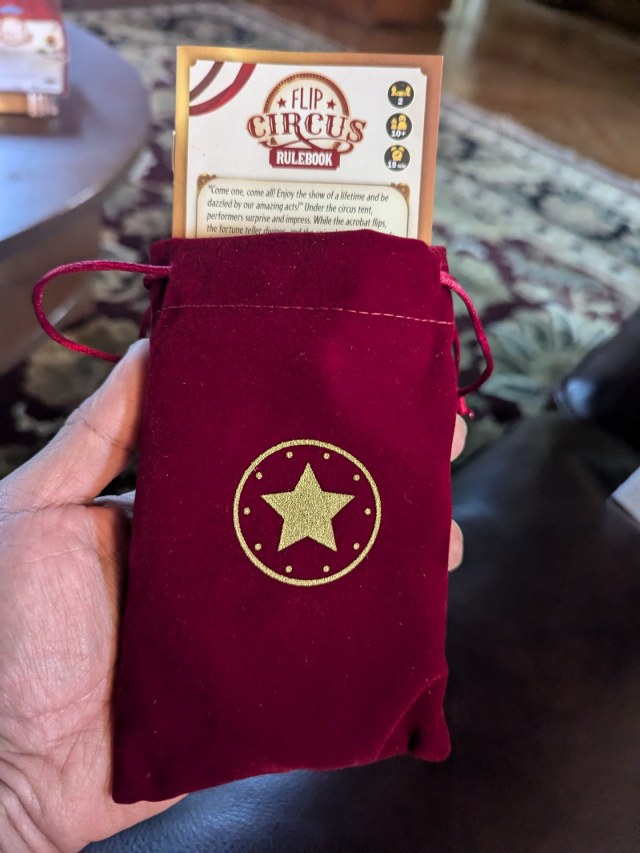Flip Circus
- Designer: Julien Gerard
- Publisher: IELLO
- Players: 2
- Age: 10+
- Time: 15 minutes
- Played with review copy provided by distributor, Flat River Games
In Flip Circus, the artists amaze the crowd as they move about the stage, but you have a larger goal in mind: using their special powers — and your recollection of which artists are where on each side of the tokens — to line up three artists of the same type. Do that, and you collect their portrait from the poster.
Collect three of the five portraits and you win — or maybe you’ll find the five clowns to let you honk your way to the victory circle…
To set up the game, set up the ring of 10 performers. First, place the 5 Clown tokens in a circular path. Then take the other 5 Performers, randomizing the faceup side (trying not to see what is on the reverse), and place one of these between each pair of Clown tokens. The color of each token is seen in the background color of the tile. Colored dots near the top show you the possible colors that can be found on the reverse. Finally, you will find an icon on the sides to remind you of the special action of that particular Performer.
Choose a starting player, and give the other player one of the five Applause tokens. The remainder of the tokens are placed in the center of the circle. The first player takes their turn, and play will alternate until one player has gained a third Poster tile.
On a turn, you get to take two actions (in any order, and you may repeat)
- Swap 2 adjacent tokens (without flipping them)
- Flip 1 Performer token without moving it
- Use 1 Performer’s instant ability – the Acrobat swaps places with the Performer directly opposite them on the circle, the Magician swaps the positions of the two tiles directly adjacent to it, and the Fortune Teller allows you to look at the back sides of BOTH tiles directly adjacent to it.
While playing your turn, be sure to remember that the Strongman and the Animal Tamer have ongoing abilities that prevent certain actions from affecting them…
At any point in your turn, you can also spend Applause tokens
- Take an additional action
- Look at the back of any token (and then return it with the original side face up)
If you ever get 3 tokens of the same Performer adjacent and face up, you take the corresponding Poster for that Performer – as long is it has not already been collected. If you take the poster, flip over the middle token of the group of 3. Note that there is no poster for the Clown. If you create a group of 2 or more Clown tokens, you can either take an Applause token from the table OR make your opponent return one of theirs to the supply.
Continue playing until a player has collected three Poster tiles; that player immediately wins!
My thoughts on the game
Flip Circus is a nice compact 2-player game filled with memory and deduction. I had some issues at first trying to come up with a strategy until I realized that the diagram on the player aid show you the possible locations of any particular performer. Yes, I know the dots on the tiles themselves tell you the same information, but I definitely was able to picture it better using the diagram.
As the game plays out, you’ll start to learn what is on the backsides of many of the tiles, and you’ll have to try to remember where those tiles go as many of the actions in the game cause tiles to change locations around the ring. It’s harder than you think to remember which tile is in what position as the game plays out.
Once you’ve identified the locations of certain Performers, then you have to try to finagle them into position to get them in a connected group of three. For these moves, I often find that I need an extra action, and this is where the Applause tokens really come in handy. Heck, for some groups, you might need even more actions – and lucky for you, there’s no limit (other than the supply itself) as to how many Applause tokens you can play on a given turn. I’ve definitely seen games won with three or four Applause tokens used on the final turn!
The components are quite nice. The chips have a nice satiny, with a somewhat iridescent finish to them, and the artwork is really nice. The player aid helps you recall the possible performers on the reverse of a chip as well as the special actions of each tile. The game itself is stored in a cloth pouch, making it easy to transport. I luckily don’t have too many bags in pouches, and since the game’s title isn’t printed anywhere on the bag, this is good as I might get confused otherwise.
Games are definitely on the quicker side, taking 5 to 10 minutes total. Sometimes the tiles just line up in a way that the poster tiles end up being collected in short order. As both players deal with the same set up, you’ll just have to be faster than your opponent in this race. And when the game goes quickly, it’s the sort of thing that is easy enough to set back up and play again.
Until your next appointment,
The Gaming Doctor







